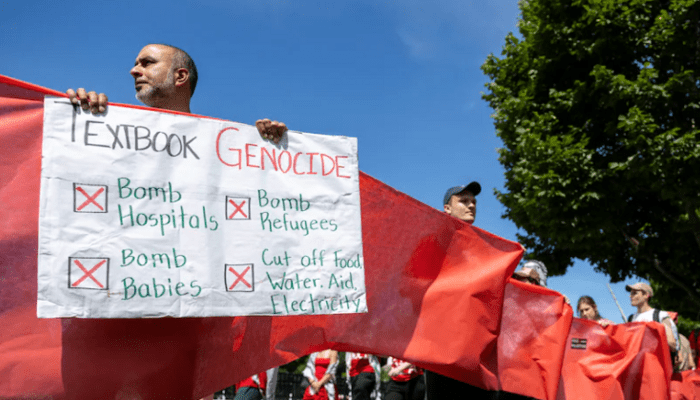The mainstream media has largely ignored the pro-Hamas protests that ramped up outside the White House this past Saturday. Despite the severity of the actions taken at these protests, including smoke bombing and vandalism, The Washington Post treated the event with a shocking casualness.
The headline of the news – “Thousands circle White House to demand Biden enforce Gaza ‘red line’,” was frightfully underwhelming for such a contentious event. It painted a picture of peaceful protesters, rather than the rabid anti-Israel activists they are. It’s curious how the word “genocide” was tossed around without a blink. Isn’t it odd that similar language isn’t used for the annual “March for Life” protest?
The Post’s Meagan Flynn wrote of the thousands who formed a ‘red line’ around The White House using fabric, as if participating in a harmless art installation. According to Flynn, these people were simply voicing concerns about President Biden’s approach to the Gaza crisis. Brian Becker, a leader of the ANSWER Coalition, one of the protest’s organizers, was quoted stating, “Only we can be the red line against genocide.” Becker failed to mention his association with Marxist-Leninist principles.
It’s intriguing that the word “Hamas” made it into this story only once, in a personal recollection from an individual named Mohammad, who is a leader in the Palestinian Youth Movement. Unsurprisingly, the word “graffiti”, associated with the vandalism committed by the protesters, only surfaced once as well.
Flynn’s tweet about the event did nothing better. She described the ‘largely peaceful’ demeanor of the protesters while showing a bland ten-second video as if it was a community gathering, rather than a protest with deep political implications.
The Washington Post’s coverage of this event starkly contrasts with how they reported earlier on the “March for Life” protest — an annual movement against abortion in January. During that report, the Post’s reporters didn’t shy away from overtly labeling the protesters as “antiabortion” and “abortion opponents” numerous times.
However, during this pro-Hamas protest, their reluctance to label the protesters as “anti-Israel” or “Israel opponents” was glaringly obvious. This breezy approach to reporting a serious demonstration, while not affording the same treatment to other protests, shows a clear bias in their reportage. It leaves one questioning the principle of fair, objective journalism.
In conclusion, The Washington Post’s sugar-coated representation of events that have severe political implications is a clear reminder of the biased reporting that plagues the media industry. The adage, ‘actions speak louder than words,’ seems to have been lost, as the Post continues to disregard objectivity in its reporting- a thing expected of a media organization of its stature.



